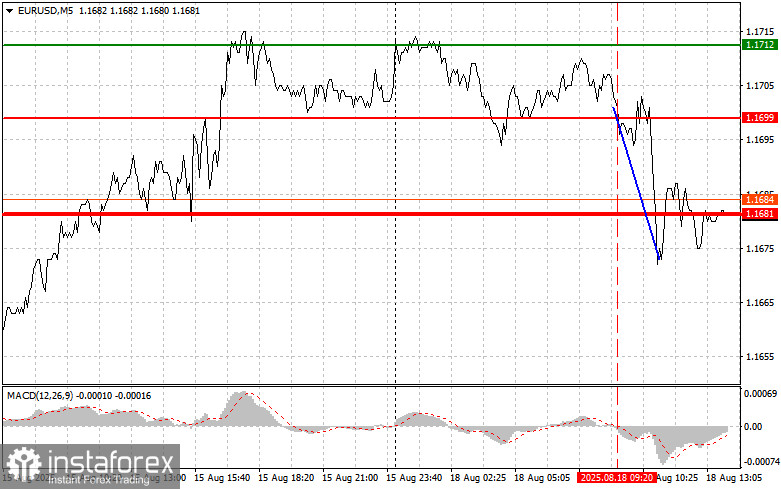Trade Review and Tips on the Euro
The test of 1.1699 coincided with the MACD indicator just starting to move down from the zero line, which confirmed the correct entry point for selling the euro and resulted in a drop of more than 25 points.
A significant decline in the euro area's trade surplus triggered a fall in the euro. Investors, concerned about worsening economic forecasts for the region and the rising risk of recession, intensified selling of euro-denominated assets. Under these circumstances, the European Central Bank faces a difficult task. On the one hand, it needs to support economic growth, which continues to suffer from trade tariffs. On the other, lowering interest rates could further fuel price pressures and slow recovery, aggravating the risk of recession.
In the second half of the day, euro pressure is unlikely to persist, as there is nothing besides NAHB housing market index data on the calendar. Of course, even this release may bring some short-term volatility, especially if the figure deviates sharply from expectations, but overall, there are no fundamental drivers today that could deepen the short-term downtrend in the single currency. Most likely, market attention will remain on analyzing existing information and assessing the ECB's next moves. Investors will closely monitor any signals pointing to the central bank's readiness to adopt a more aggressive stance.
As for intraday strategy, I will mainly rely on Scenarios #1 and #2.

Buy Signal
Scenario #1: Buying the euro today is possible at 1.1688 (green line on the chart), with a target at 1.1712. At 1.1712, I plan to exit the market and also sell the euro in the opposite direction, expecting a move of 30–35 points from the entry. A strong rise in the euro is unlikely today.Important! Before buying, make sure that the MACD indicator is above the zero line and just starting to move up.
Scenario #2: I also plan to buy the euro if there are two consecutive tests of 1.1674 while the MACD indicator is in the oversold area. This would limit the pair's downward potential and lead to a reversal upward. Growth toward 1.1688 and 1.1712 can be expected.
Sell Signal
Scenario #1: I plan to sell the euro after reaching 1.1674 (red line on the chart). The target will be 1.1653, where I intend to exit and buy immediately in the opposite direction (expecting a rebound of 20–25 points from that level). Pressure on the pair will return in case of strong U.S. data.Important! Before selling, make sure that the MACD indicator is below the zero line and just starting to move down.
Scenario #2: I also plan to sell the euro if there are two consecutive tests of 1.1688 while the MACD indicator is in the overbought area. This would limit the pair's upward potential and lead to a reversal downward. A decline toward 1.1674 and 1.1653 can be expected.

What's on the chart:
- Thin green line – entry price for buying the instrument;
- Thick green line – assumed price for placing Take Profit or manually securing profit, as further growth above this level is unlikely;
- Thin red line – entry price for selling the instrument;
- Thick red line – assumed price for placing Take Profit or manually securing profit, as further decline below this level is unlikely;
- MACD indicator – when entering the market, it is important to follow overbought and oversold zones.
Important. Beginner traders in the Forex market should be very cautious with entry decisions. Before the release of important fundamental reports, it is best to stay out of the market to avoid sharp price swings. If you choose to trade during news releases, always place stop orders to minimize losses. Without stop orders, you can quickly lose your entire deposit, especially if you do not use money management and trade with large volumes.
And remember, successful trading requires a clear trading plan like the one outlined above. Spontaneous decisions based on current market movements are an inherently losing strategy for intraday traders.





















